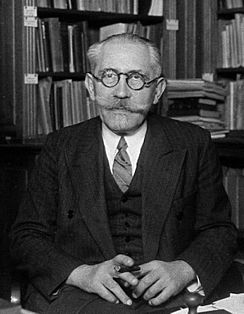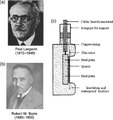Paul Langevin facts for kids
Quick facts for kids
Paul Langevin
|
|
|---|---|
 |
|
| Born | 23 January 1872 Paris, France
|
| Died | 19 December 1946 (aged 74) Paris, France
|
| Alma mater | University of Cambridge Collège de France University of Paris (Sorbonne) ESPCI |
| Known for | Langevin equation Heisenberg–Langevin equations Langevin dynamics Langevin function Twin paradox |
| Awards | Hughes Medal (1915) Copley Medal (1940) Fellow of the Royal Society |
| Scientific career | |
| Fields | Physics |
| Institutions | ESPCI École Normale Supérieure |
| Thesis | Research on ionized gases (1902) |
| Doctoral advisors | Pierre Curie Joseph John Thomson Gabriel Lippmann |
| Doctoral students | Louis de Broglie Léon Brillouin |
| Signature | |
Paul Langevin (born January 23, 1872 – died December 19, 1946) was an important French physicist. He is famous for creating ideas like Langevin dynamics and the Langevin equation. These are used to describe how tiny particles move.
Langevin was also a strong opponent of fascism, a type of government that is very controlling. He helped start a group called the Comité de vigilance des intellectuels antifascistes (Committee of Vigilance of Anti-Fascist Intellectuals). This group was formed to speak out against fascism. Because he was so outspoken, the Vichy government (which ruled France during part of World War II) arrested him. He was kept under house arrest for most of the war.
After the war, from 1944 to 1946, Langevin was the president of the Human Rights League. This group works to protect people's rights. He had also recently joined the French Communist Party. Paul Langevin was a student of Pierre Curie. He is also known for his inventions with Constantin Chilowsky. They created ways to detect submarines using ultrasonic sounds. He is buried in the Panthéon in Paris, a special place for famous French people.
Contents
Early Life and Education
Paul Langevin was born in Paris, France, on January 23, 1872. He was a very bright student. He studied at two important schools in Paris. These were the École de Physique et Chimie and the École Normale Supérieure.
After his studies in France, he traveled to England. He went to the University of Cambridge. There, he studied at the Cavendish Laboratory with Sir J. J. Thomson. Thomson was a famous scientist who discovered the electron.
Langevin then returned to France. He earned his PhD from the Sorbonne in 1902. His advisor was the famous physicist Pierre Curie. In 1904, he became a Professor of Physics at the Collège de France. Later, in 1926, he became the director of the École de Physique et Chimie, where he had once been a student. In 1934, he was chosen to be a member of the Académie des sciences.
Scientific Discoveries
Paul Langevin made many important contributions to physics. He is well known for his work on paramagnetism and diamagnetism. These are properties of materials related to how they react to magnetic fields. He helped explain these ideas by looking at how tiny electrons behave inside atoms.
Ultrasound and Submarine Detection
One of his most famous works involved using ultrasound. Ultrasound uses sound waves that are too high for humans to hear. Langevin used the piezoelectric effect, which was discovered by Pierre Curie. This effect shows how certain materials can create electricity when squeezed, or vibrate when electricity is applied.
During World War I, Langevin started working on a way to use these sounds. His goal was to detect submarines underwater using echo location. This is like how bats use sound to "see" in the dark. He worked with Constantin Chilowsky on this project. They filed two US patents in 1916 and 1917. These patents described the first ultrasonic submarine detector. It measured how long it took for sound to travel to a submarine and bounce back. This allowed them to calculate the distance to the submarine.
Even though the war ended before his device was fully ready, his work was very important. It laid the groundwork for modern sonar technology. In the UK, Lord Ernest Rutherford and Robert William Boyle were also working on similar piezoelectric detectors for submarines.
Theory of Relativity
Paul Langevin also played a key role in spreading Albert Einstein's theory of relativity in France. He helped other scientists understand this complex idea. He also created what is now known as the twin paradox. This is a thought experiment that explores how time can pass differently for people moving at very high speeds.
Family Life
In 1898, Paul Langevin married Emma Jeanne Desfosses. They had four children together: Jean, André, Madeleine, and Hélène.
Later in his life, in 1933, he had another son, Paul-Gilbert Langevin, with physicist Eliane Montel. Paul-Gilbert grew up to become a famous musicologist.
His daughter, Hélène Solomon-Langevin, was a brave member of the French Resistance. This was a group that fought against the German occupation of France during World War II. She was arrested for her activities. She survived several concentration camps during the war.
Later Years and Legacy
Langevin was a strong voice against Nazism. Because of his views, the Vichy government removed him from his teaching position after Germany occupied France. However, he was given his position back in 1944. This was after the Liberation of Paris, when the city was freed from German control.
Paul Langevin died in Paris in 1946. He is buried in the Panthéon in Paris. This is a special place where many important French figures are laid to rest. His work in physics, especially with ultrasound and relativity, continues to be studied and used today.
See also
 In Spanish: Paul Langevin para niños
In Spanish: Paul Langevin para niños
- Born coordinates, for the Langevin observers in relativistic physics
- Langevin dynamics
- Langevin equation
- Langevin function
- Brillouin and Langevin functions
- Solvay Conference
- Brownian motion
- Special relativity
- Institut Laue–Langevin
Images for kids
-
Albert Einstein, Paul Ehrenfest, Paul Langevin, Heike Kamerlingh Onnes, and Pierre Weiss at Ehrenfest's home in Leiden in the Netherlands
-
Pioneers in the development and application of piezoelectric transducers for the goal of submarine detection (a) Paul Langevin, (b) Robert William Boyle, (c) Cross-sectional view of a form of quartz transducer designed by Boyle in 1917, as recorded in the BIR (Board of Invention and Research) document 38164/17
Sources
- Asimov's Biographical Encyclopedia of Science and Technology, Isaac Asimov, Doubleday & Co., Inc., 1972, ISBN: 0-385-17771-2.
- References to the affair with Marie Curie is found in Françoise Giroud (Davis, Lydia trans.), Marie Curie: A life, Holmes and Meier, 1986, ISBN: 0-8419-0977-6, and in Quinn Susan, Marie Curie: A Life, Heinemann, 1995, ISBN: 0-434-60503-4.
- Wolfram research biographical entry by Michel Barran.
- Annotated bibliography for Niels Bohr from the Alsos Digital Library for Nuclear Issues



